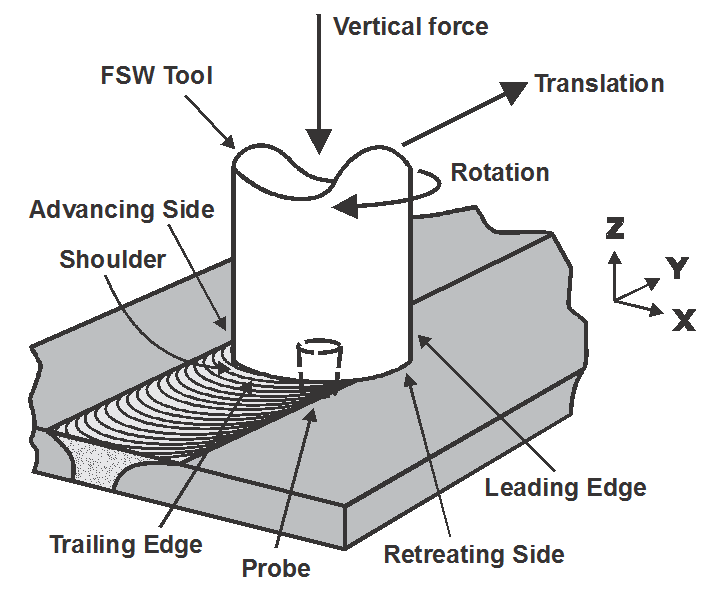 Friction stir welding is a type of solid-state joining process that utilizes a non-consumable item or tool to join two or more workpieces without melting them. According to MegaStir, heat is generated through the process of friction between two rotating tools and the workpiece material. This result in a softened section or region near the friction stir welding tool.
Friction stir welding is a type of solid-state joining process that utilizes a non-consumable item or tool to join two or more workpieces without melting them. According to MegaStir, heat is generated through the process of friction between two rotating tools and the workpiece material. This result in a softened section or region near the friction stir welding tool.
While the FSW tool is traversed along a joint line, it physically and mechanically mixes the two metals and forges the softened and hot metal material using mechanical pressure. This pressure is applied by the friction stir welding tool which results in a joining clay or dough.
The friction stir method is basically used on extruded aluminum or wrought and more specifically for structures that need a high welding strength. This process is also found in the current or modern shipbuilding, aerospace, and train applications. This technique was established and experimentally approved by the Welding Institute in the United Kingdom in 1991. The institution held patents on the welding process with the first being among the most descriptive.
The Principle of Operation
In this process, a cylindrical and shouldered instrument with profiled probes is rotated and carefully plunged into a joint between the two pieces of the plate or sheet materials that are to be joined together. The parts to be welded together must be clamped on various backing bars in a way that prevents the abutting weld joint faces from being moved or forced apart. The resulting plasticized component is transferred from the main edge of the weld tool to the trailing edge before joining together. This process can easily be regarded as the solid-phase keyhole metal welding method since a hole is created to accommodate the probe.
The friction stir method was originally used with low-melting-temperature materials since the initial component materials could not hold up due to the pressure of the stirring and high-temperature metal materials such as steel and other high-strength metals. This issue no longer exists since the new technologies such as tungsten-rhenium, polycrystalline cubic boron nitride, and ceramics work well in such cases. Also, the application of the liquid-cooled tool holder and the telemetry unit refined the whole process and capability.
Friction Stir Welding User End Products
The friction stir welding technique has demonstrated its capabilities in the welding industry. This process has been experimentally approved for joining various metals including aluminum. Since 1996, this technology has been in use across an array of the industrial spectrum of applications. Some of the friction stir welding end-user products include.
- Aerospace: In airframe structures, the friction stir welding process was used in the joining of the fuel tanks and other components on the satellite launch vehicles in the 1990s. The friction stir welding led to improved joint efficiency, reduced work, strength, and substantial cost saving. Using the friction stir welding process in aircraft, the aluminum material stringers to the skins of the aircraft wings and fuselage structures reduced the weight by removing thousands of the rivets, and any overlapping metal materials.
- The Thermal Industrial Products: Friction stir welding is also used in the thermal industry companies to create and develop current and innovative parts and solutions. The products are stronger, hermetically sealed, lighter and reliable. These products include but not limited to extrusions, castings custom, heat sinks and the cold plates. This process adds new, durable and improved thermal products as well as improving the aesthetic quality of the materials.
- Railway: The current railway carriages are the products of the longitudinal aluminum extractions with a few integrated stiffeners. The entire body shell is also a product of either hollow-double skin or single-wall aluminum extractions using the friction stir welding process.
This design technique enhances the crashworthiness of the vehicles since there is no transverse welds and the buckling strength of the main panels under the longitudinal compression.
Where the Friction Stir Welding Is Used
The friction stir welding method has originally been patented by the TWI in many industrialized nations and licensed for more than 183 users. The process and its variants, the friction stir processing, and the friction stir spot welding are used for several industrial applications including shipbuilding and offshore, general fabrication, computers, robotics, automotive, aerospace, and the rolling stock for railways.
Learn more
Whether you're looking for exceptional specialty alloys, cast irons, or some other product, finding the ideal welding company is important. In man ...
Welding is one of the fascinating things because human beings are in a way like some insects. Most people normally stare for a while when they see ...
In the past, it was thought that there were only a couple of metals that would actually work to create machinery for the aerospace industry, but n ...
In the area of commercial metal coatings, physical vapor deposition, or PVD is becoming a popular process for metalizing a product. Metalization i ...
Ceramic Fiber products are in great demand by many businesses as a means of controlling heat. It is most widely used by companies with manufacturi ...







